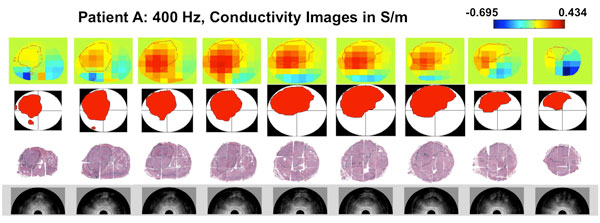Electrical Property-based Image-Guided Prostate Biopsy
With funds from the NIH and the NIBIB, we are developing a tool capable of providing more accurate pathological imaging during the biopsy procedure. We are integrating electrical property imaging and sensing technology into a standard clinically accepted TRUS-guided biopsy procedure to better guide tissue sampling and provide urologists more specific imaging studies better describing the extent of the disease.
Diagnostic confirmation of prostate cancer currently relies solely on TRUS-guided biopsy findings, with biopsy-based measures including Gleason grade and tumor involvement largely influencing therapeutic staging. There is a lack of concordance between these biopsy measures and those found in radical prostatectomy specimens. Clinical TRUS imaging also has a limited sensitivity and specificity for identifying the pathology of focal lesions during these biopsy procedures.
Our electrical impedance imaging (EII) device couples a flexible array of electrodes directly to a clinical TRUS probe to provide co-registered US and electrical property images. We have also developed an electrical impedance spectroscopy (EIS) sensor integrated into a standard 18-gauge prostate biopsy (Bx) needle to permit sensing of tissue electrical properties in tandem with tissue core extraction. By coupling the EIS-Bx device to the EII device, and using the elements of the EIS-Bx instrument as a set of electrodes internal to the prostate, we are improving sensitivity throughout the entire volume of the gland and enhancing imaging of these highly disease specific electrical properties.

Example suite of images collected from the EII system along with pathology and ultrasound. From top to bottom the rows represent electrical impedance tomography conductivity reconstructions, pathological maps (red denotes where cancer is located), digitized histology prostate cross-sections and ultrasound slices. Left to right represents axial cross-sections of the prostate from apex to base.